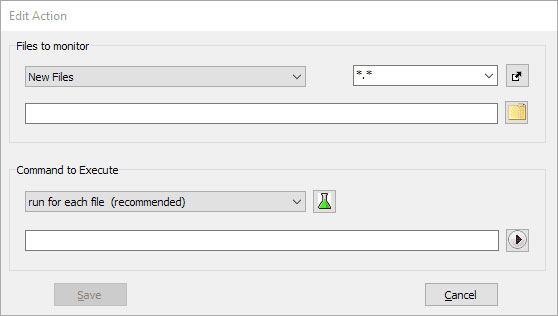

This is also done on the dashboard view, just click on config, additional field defaults, computers, and then backup. Next, we'll set a default value for the extra data field that will be assigned to all computers.

Lastly one more pipe character and then the number two to indicate a drop-down list. Next, is a pipe character followed by a description in this case maximum age in hours of last successful ShadowProtect SPX backup. For example, I have values of no backups expected, 240, 168, and so on. And fill is a bit complicated but not too bad it's a tilde separated list of values that will appear in the drop-down. Then click config, configurations, additional fields, computers. Navigate to system, configuration, and then dashboard. I'll start by creating an extra data field that will define the acceptable backup agent hours on a per computer basis.
Automate file monitor how to#
This is very useful for seeing detailed status on demand, but I'll show you now how to leverage the same underlying data that drives this plug-in to create internal monitors to ensure backups are up-to-date and within recovery point objectives required by your service level agreements. Clicking on the tile will launch the main StorageCraft plug-in view where you can do many operations and also see detailed backup history. You can see the last success and next scheduled backup on the overview tile. The Automate plug-in solution allows you to easily install, license, and see backup status and history of all machines running SPX from inside control center. For example, this is a server running SPX and backing up the two volumes on the server. In this tutorial I’ll show you how to expand the StorageCraft solution for ConnectWise Automate to create some simple but very effective internal monitors to ensure your ShadowProtect SPX backups are up-to-date and you can meet you SLAs.įor those not familiar, StorageCraft ShadowProtect SPX is a full-image backup and recovery product for physical and virtual machines. Alternatively, see the guide Advanced FTP/SFTP scripting for examples of checking script results (including XML log parsing) using more powerful languages and the guide to Interpreting XML log for advanced scripting using C# language.Hello. If you require checking results of each command individually, you should better use the WinSCP. ini=nul /log=example.log /script=example.txtĪ similar error handling is used in the batch file template that WinSCP can generate for you. You should also make the batch file indicate a result in its exit code, particularly if it is called from some parent system (for example SSIS). Once you find out what was the result of the script, you can perform any action you like: print a message, send an email, etc.


Automate file monitor code#
Automate file monitor windows#
For complex tasks, you will need to use some scripting language, such JScript or VBScript from Windows script host or PHP or Perl.įollowing example shows batch file that takes filename on command line and generates WinSCP script file to upload that file to remote server: For simple tasks you can use built-in Windows scripting functionality from batch file (. To automate that, make a wrapper script file. You can also use environment variables in the script.Īlternatively, you can generate new script file each time. ini=nul /script=script.tmp /parameter // c:\myfile.txt NET assembly.įor simple modifications, you can pass the variable parts of the script from command line: For example you may want to operate it with different file each time.įor tasks involving more complex modifications, conditional processing, loops or other control structures, you should better use the WinSCP. You may want to modify the script automatically.


 0 kommentar(er)
0 kommentar(er)
